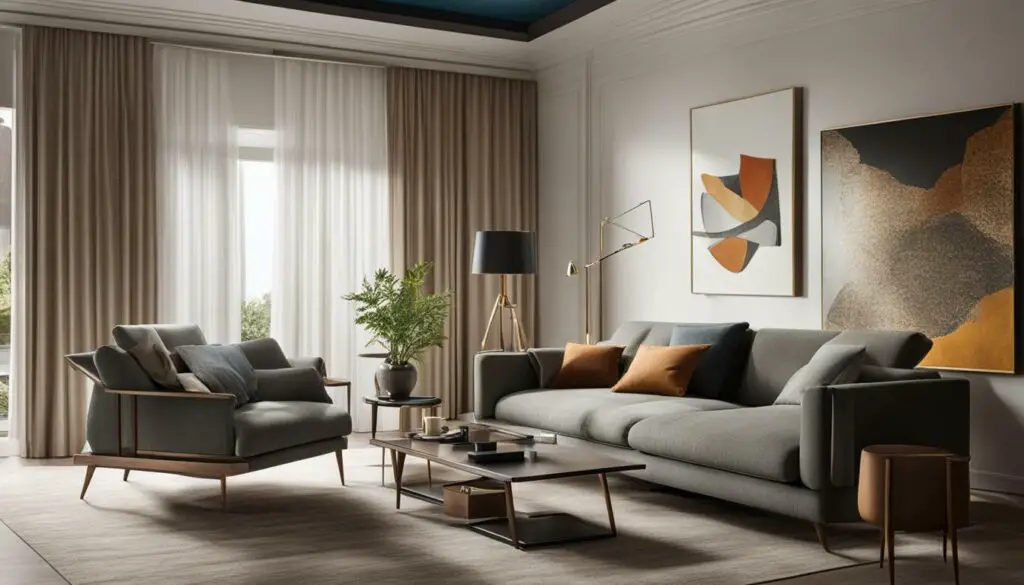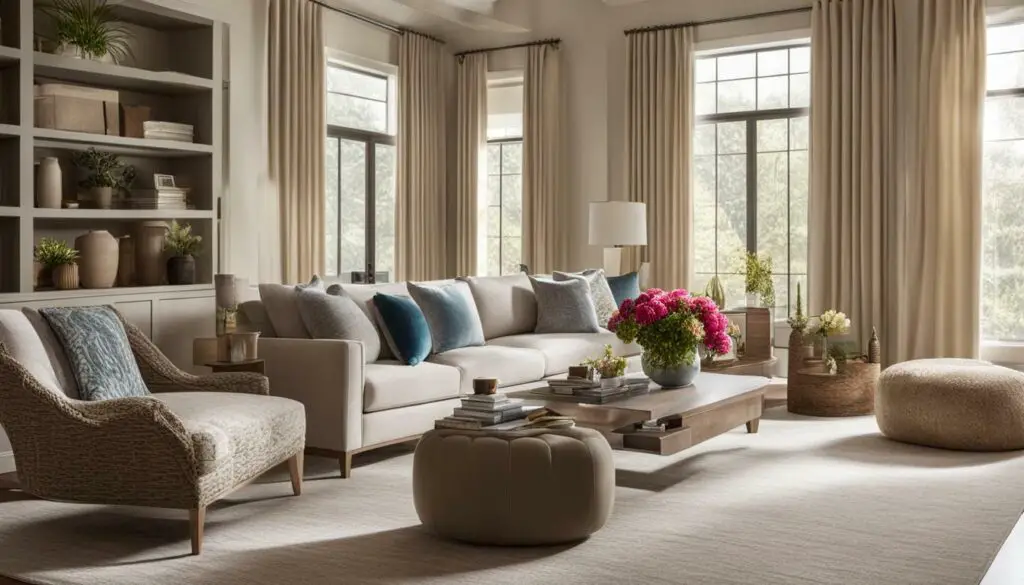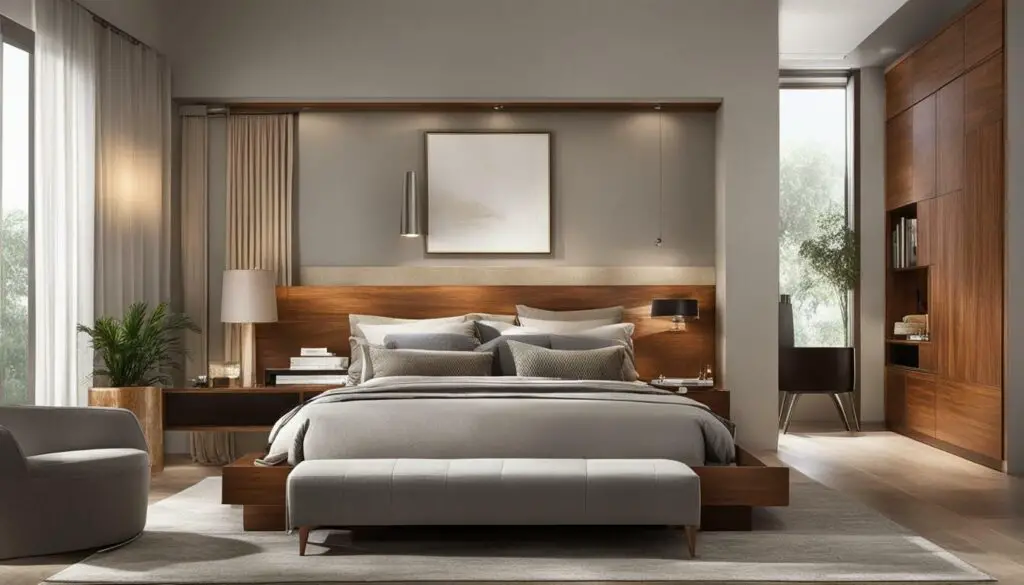Arranging furniture in your home can be a daunting task, especially if you’re short on space or unsure of where to start. But with a few expert tips and ideas, you can create a stylish and functional living space that reflects your personal style and makes the most of the available square footage.
In this section, we’ll provide you with some furniture arrangement tips and ideas that can help you optimize space and create a harmonious layout in your home. From choosing the right furniture pieces to arranging them in a way that makes sense, these tips will help you transform your living space effortlessly.
Whether you’re starting from scratch or looking to refresh an existing layout, these furniture arrangement tips and ideas are sure to inspire you. So let’s get started!
Key Takeaways:
- Optimizing space is key to creating a harmonious furniture arrangement.
- Choosing the right furniture pieces can make a big difference.
- Creating a focal point can help tie the room together.
- Arranging furniture in a way that makes sense for the room’s layout is important.
- Experimenting with different arrangements can help you find the perfect fit.
Efficient Furniture Arrangement for Small Spaces
Living in a small space requires creativity and clever furniture arrangement to make the most of every square inch. Whether you’re living in a studio apartment or have a cozy bedroom, optimizing your furniture placement can make all the difference in creating a spacious and functional home. Here are some expert tips for an efficient furniture arrangement for small spaces.
1. Determine Your Needs
Before you start rearranging your furniture, think about your daily activities and what pieces of furniture you actually need. If you work from home, you may need a designated workspace, while if you’re a frequent entertainer, you’ll want to make sure you have enough seating. By knowing your specific needs, you can better plan your furniture arrangement to maximize your space.
2. Consider Multipurpose Furniture
One of the best ways to save space in a small room is by using furniture pieces that serve multiple purposes. For example, a sofa bed can provide seating during the day and a comfortable bed at night for guests. A storage ottoman can serve as a place to rest your feet while also providing space to store blankets or other items.
3. Use Vertical Space
When you have limited floor space, it’s important to look up and utilize vertical space. Adding shelves or bookcases to your walls can provide extra storage without taking up valuable floor space. You can also use a hanging organizer to store shoes or other items, or install a fold-down desk to create a workspace that can be easily stored away when not in use.
4. Create Zones
Dividing your small space into different zones can help create the illusion of separate rooms. For example, you could use a bookcase or folding screen to separate your bedroom from your living area. By creating distinct zones, you can give each area its own purpose and make the most out of your space.
5. Optimize Traffic Flow
When arranging furniture in a small space, it’s important to consider traffic flow. Make sure there is enough room for people to move around without bumping into each other. Avoid placing furniture near doorways or in walkways, and consider using folding chairs or stools that can be easily moved when needed.
By following these efficient furniture arrangement tips, you can transform your small space into a functional and stylish home.

Creating a Welcoming Living Room Furniture Arrangement
Your living room is the place where you spend most of your downtime, so it’s important to create a warm and inviting ambiance. But how do you go about arranging your furniture in a way that maximizes comfort and functionality? Here are a few furniture placement tips and interior design ideas to help you create a welcoming living room:
- Start with a focal point: Whether it’s a fireplace, a large window, or a piece of art, your living room should have a central point of focus. Arrange your furniture around this point to create a cozy and intimate atmosphere.
- Think about traffic flow: Your furniture placement should allow for easy movement around the room. Make sure to leave enough space between furniture pieces for people to pass through comfortably.
- Create different seating areas: Depending on the size of your living room, you can create separate seating areas to accommodate different types of activities. For example, you could have a sofa and armchairs for watching TV, a reading nook with a comfortable chair and a side table, and a coffee table with seating for drinks and snacks.
- Add rugs and accessories: Rugs and accessories can add texture and color to your living room, creating a cohesive and stylish look. Make sure to choose pieces that complement your furniture and overall decor.
By following these furniture placement tips and interior design ideas, you can create a living room that is both functional and welcoming.

Bedroom Furniture Placement for a Peaceful Retreat
Your bedroom should be a sanctuary of peace and relaxation. One key aspect of creating a peaceful environment is by arranging your furniture in a way that maximizes comfort and functionality. Here are some tips to help you achieve this:
- Place your bed against a solid wall for stability and a restful sleep.
- Avoid placing your bed directly in front of a window, as this can disrupt your sleep and create uncomfortable drafts.
- If you have a small bedroom, consider using a platform bed with built-in storage to save space and reduce clutter.
- Use bedside tables to store your nighttime essentials, such as books, glasses, and a lamp for reading.
- If you have a large bedroom, create a seating area with a comfortable armchair or a bench to make your room feel more inviting.
When it comes to bedroom furniture placement, less is often more. Avoid cluttering your space with unnecessary furniture, and instead focus on creating a calming atmosphere that promotes rest and relaxation.
Interior Design Tip:
“When selecting bedroom furniture, opt for pieces that reflect your personal style and bring you joy. Your bedroom should be a reflection of your personality and a space that makes you happy.”
By arranging your bedroom furniture in a way that optimizes your space and promotes relaxation, you can create a peaceful retreat that helps you unwind and recharge.

Room Layout Ideas for Every Home
Are you struggling with furniture placement in your home? Whether you have a small space, an open-concept area, or a few separate rooms, there are plenty of room layout ideas that can work for you. Follow these furniture arrangement tips and furniture placement tips for a well-balanced and visually appealing living space.
1. Define the Purpose of Each Room
Before you start arranging furniture, it’s important to determine the purpose of each room. For example, your living room may be a space for relaxation and entertainment, while your home office needs to be functional and conducive to productivity. Once you have a clear idea of how you want to use each room, you can plan furniture placement accordingly.
2. Create a Focal Point
A focal point is a design element that draws attention and anchors the room. It can be a fireplace, a piece of artwork, or a window with a beautiful view. Once you have a focal point, arrange furniture around it to create a cohesive and visually appealing look. For example, you could place a sofa and two chairs around a fireplace in a symmetrical arrangement.
3. Consider Traffic Flow
When arranging furniture, make sure to leave enough space for people to move around without feeling cramped. Consider the traffic flow in each room and plan furniture placement accordingly. For example, if you have a narrow hallway, avoid placing large furniture items that could obstruct the path.
4. Use Natural Light
Maximize natural light in your living space by arranging furniture to face windows or doors. This will not only make the room feel brighter and more spacious, but it will also create a welcoming and inviting atmosphere. Alternatively, you can use curtains or blinds to control the amount of light and create a cozy ambiance.
5. Mix and Match Furniture
Don’t be afraid to mix and match furniture pieces to create a unique and personalized look. For example, you can pair a traditional sofa with a contemporary coffee table, or mix different patterns and textures to add visual interest. However, make sure to maintain a cohesive style and color palette to avoid a cluttered and chaotic look.
With these room layout ideas and furniture arrangement tips, you can transform your living space into a stylish and functional home. Experiment with different layouts and don’t be afraid to take risks – after all, your living space should reflect your personality and lifestyle.

